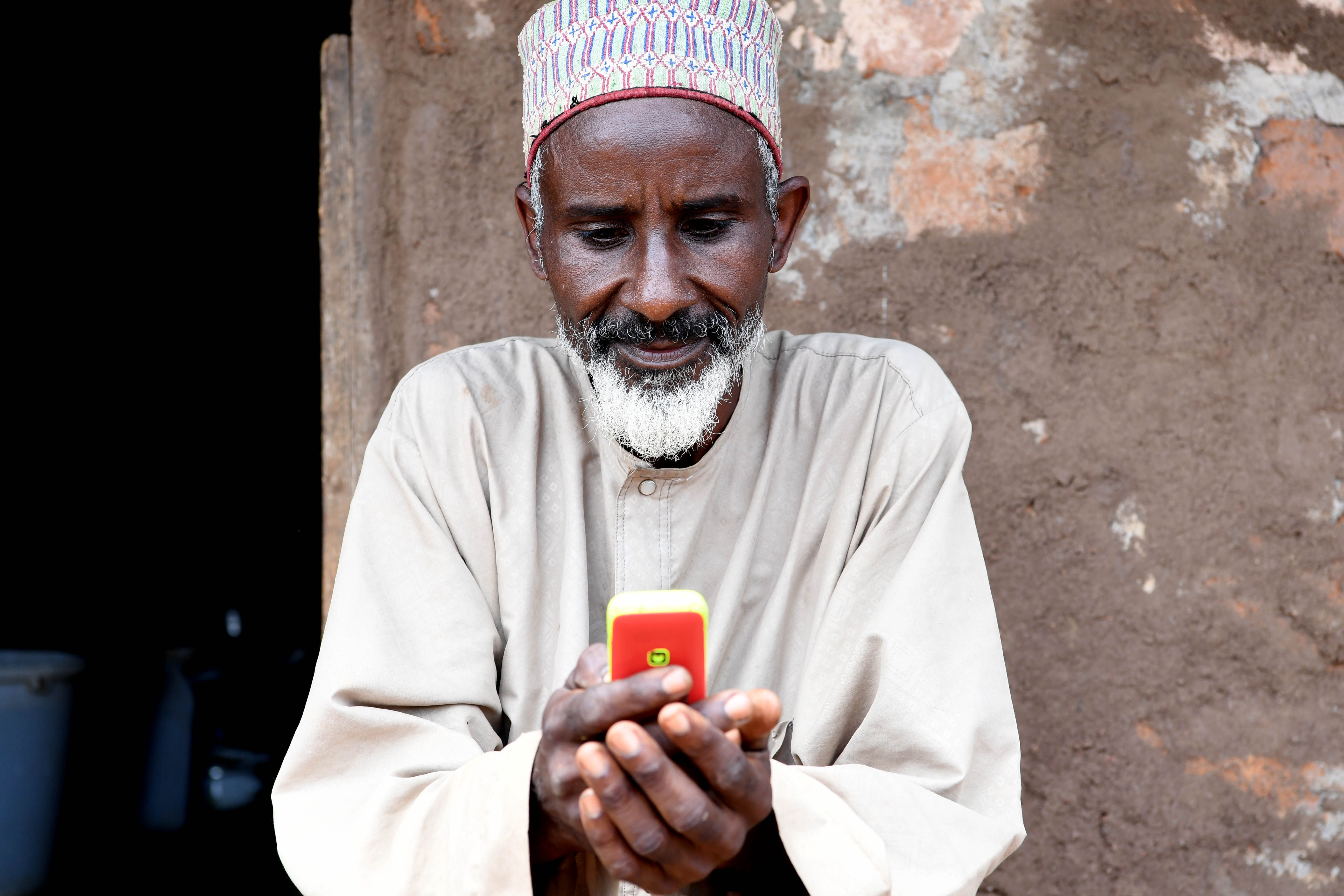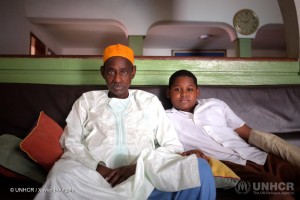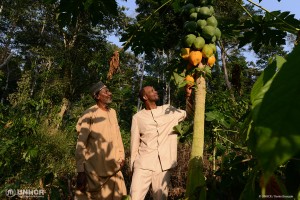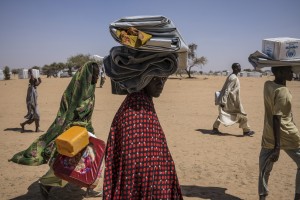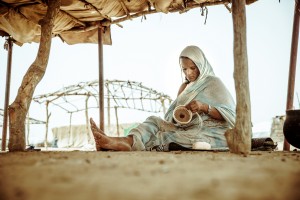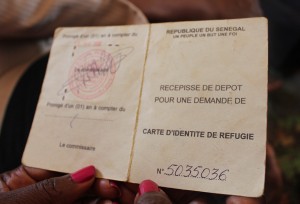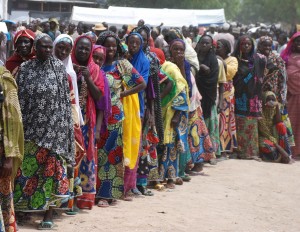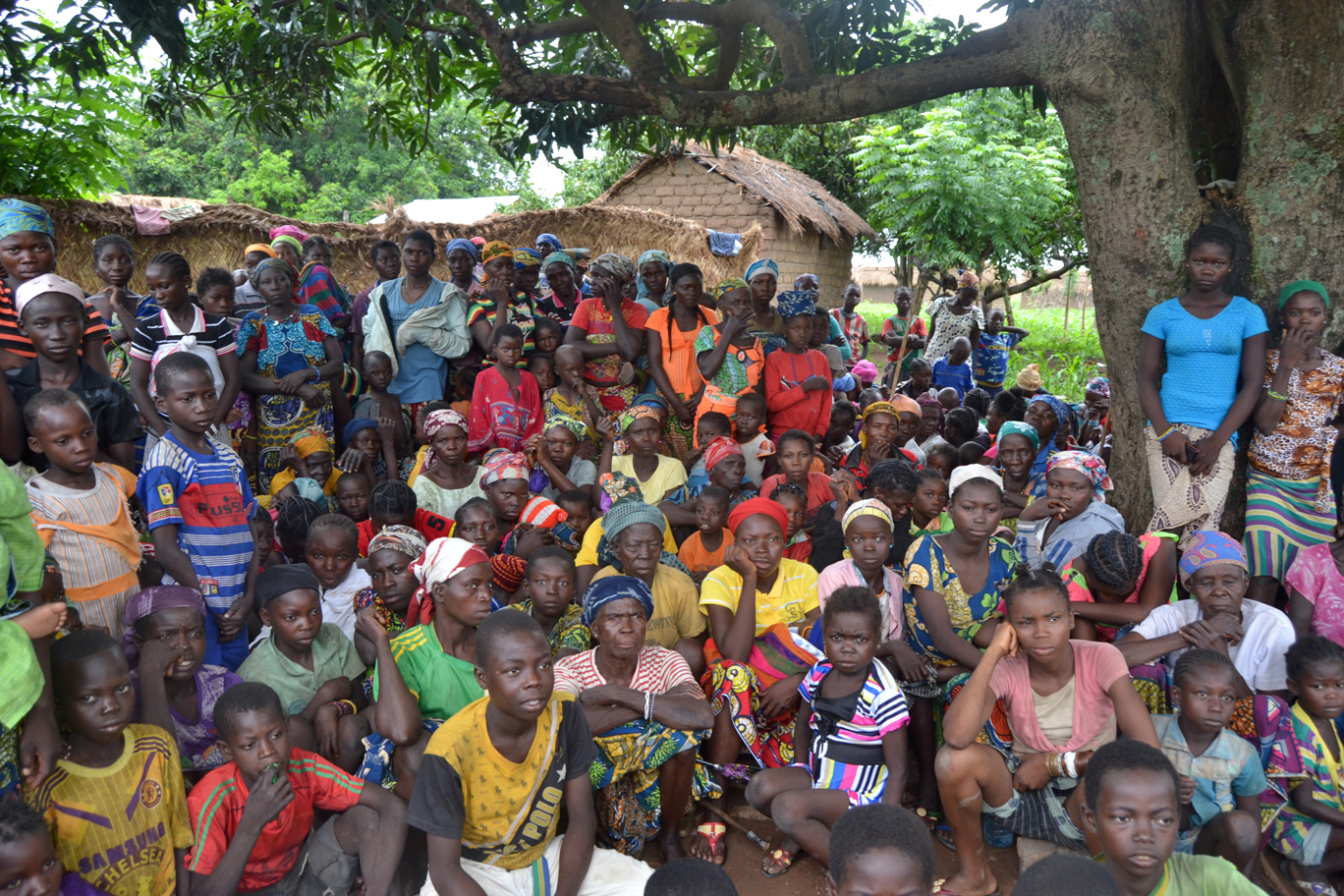More than 6,000 people flee to Chad and Cameroon to escape violence in the Central African Republic
Most new refugees are women and children, they arrived exhausted, hungry and traumatized
N’DJAMENA, CHAD, 8 July 2016 (UNHCR) – Thousands of people from Central African Republic (CAR) have crossed the border into Chad and Cameroon to escape renewed tension and fighting since mid-June in their fragile country and we fear that more will come. UNHCR staff in southern Chad have helped the Government’s national refugee commission register more than 5,643 CAR refugees in the villages of Sourouh and Mini, located near Mbitoye, some three and seven kilometres from the border. Screening and registration of new arrivals is continuing. A further 555 refugees have crossed to Yamba village in eastern Cameroon.
The exodus began on June 12 when clashes erupted between livestock herders and local arable farmers in and around the north-west town of Ngaoundaye, Ouham Pende region. Such clashes have become a seasonal occurrence as herders move their animals across the land. But this year, disturbingly, rival ex-Seleka and anti-Balaka militias have become involved.
The more intense and escalated fighting this year has also affected a further 25,000 to 30,000 people within CAR, including many internally displaced in addition to those fleeing to Chad and Cameroon. New arrivals said many people had fled to the bush and might try to cross borders if the situation does not improve. UNHCR shares growing international concern about the displacement and the rising tension and clashes, including in Bangui.
Refugees arriving in the two neighbouring countries, which already host tens of thousands of refugees from CAR, said they had seen killings, kidnappings, looting and the torching of their homes. Most fled direct attacks on their villages while some said they had run away fearing the fighting would come to their homes. People reported the presence of heavily armed fighters. Although most are women, children and the elderly, more men are fleeing and leaving behind their livelihoods. In Chad, where people have been crossing despite the border being officially closed, about two thirds of arrivals are aged under 18 years and 450 of them were unaccompanied or separated from their families.
The majority of household heads are women and more than 20 per cent of those arriving have been identified by UNHCR protection staff as vulnerable with specific needs. They are arriving in a poor state; exhausted, weak and hungry with many traumatized. Some have health problems, including malaria, respiratory infections and malnutrition at the height of the rainy season. These people, crammed into structures provided by the village host community, need urgent aid, including shelter, food and medical care.

UNHCR and partners register new refugees arriving from the Central African Republic (CAR) in the Chadian village of Mini, one of the three locations near the borders hosting new arrivals since mid-June. © UNHCR / Victorien Ndakass
UNHCR and the government are working with inter-agency partners to provide emergency assistance to the new arrivals while preparing to relocate the new arrivals to host villages some 45 kilometres from the border, rather than create new camps. When these host villages are ready and people relocated, starting next week, UNHCR and its partners will provide basic social services to the refugees and host communities and encourage integration.
In Cameroon, 137 of the 555 CAR arrivals in mid-June from the Bocaranga region were transferred to Ngam refugee site, where biometric registration will be carried out. They cited attacks on their villages and threats of reprisals for fleeing. This followed an influx at Yamba in late April of 716 people. About 70 per cent of the CAR refugees in Cameroon live in host communities and 30 per cent live in refugee sites. The needs of the new arrivals included health care, construction or rehabilitation of water outlets, education access and facilities. UNHCR is monitoring the border for more crossings and distributing aid.
The latest violence comes barely six months after the election of President Faustin Archange Touadera ushered in hopes of lasting peace after three years of escalated conflict that left thousands dead and almost 1 million displaced. Before the new influx, UNHCR and its partners were providing protection and assistance to over 67,000 CAR refugees in southern Chad and some 260,000 in Cameroon. There are also 415,000 internally displaced people within CAR. UNHCR has appealed for US$225.5 million for its CAR situation operations, but has only received US$24.7 million to date, or about 11 per cent.
For more information on this topic, please contact:
In Dakar, Hélène Caux, caux@unhcr.org, +221 77 333 1291
In Ndjamena, Ibrahima Diane, dianei@unhcr.org, +23565274775
In Yaounde, Djerassem Mbaiorem mbaiorem@unhcr.org, +237 70 40 1841
In Geneva, Leo Dobbs, dobbs@unhcr.org, +41 79 883 6347

Refugee women and children wait to be registered in the Chadian village of Mini. They fled fresh clashes between armed groups in Ngaoundaye, in the north-west of the Central African Republic.
Le texte en français:
Regain de violences en République centrafricaine: plus de 6000 personnes fuient vers le Tchad et le Cameroun
Des milliers de ressortissants centrafricains ont traversé la frontière vers le Tchad et le Cameroun pour échapper à un regain de tension et des combats depuis la mi-juin dans leur pays fragile et nous craignons encore davantage d’arrives. Le personnel du HCR au sud du Tchad a apporté son appui à la Commission nationale d'accueil et de réinsertion des réfugiés et des rapatriés (CNARR) pour enregistrer quelque 5643 réfugiés centrafricains dans les villages de Sourouh et Mini, près de Mbitoye, quite trouvent entre trois à sept kilomètres de la frontière. Le contrôle et l’enregistrement des nouveaux arrivants se poursuit. Un autre groupe de 555 réfugiés a traversé la frontière vers le village de Yamba à l'Est du Cameroun.
L'exode a commencé le 12 juin lorsque des affrontements ont éclaté entre des éleveurs et des cultivateurs locaux dans et autour de la ville de Ngaoundaye, dans la région de Ouham Pende au nord-ouest. Ces affrontements sont devenus un phénomène saisonnier quand les éleveurs déplacent leurs animaux à travers le pays. Mais cette année, de façon inquiétante, les milices rivales ex-Séléka et anti-Balaka ont également été impliquées dans ces affrontements.
Les combats violents et plus intenses cette année ont également affecté entre 25 000 et 30 000 personnes en République centrafricaine, y compris un grand nombre de déplacés internes, en plus des personnes ayant fui vers le Tchad et le Cameroun. Les nouveaux arrivants ont indiqué que beaucoup avaient fui dans la brousse et pourraient essayer de traverser les frontières si la situation ne s'améliore pas. Le HCR partage la préoccupation croissante de la communauté internationale sur le déplacement et la montée des tensions et des affrontements, notamment à Bangui.
Les réfugiés arrivés dans les deux pays voisins - qui accueillent déjà des dizaines de milliers de réfugiés centrafricains - ont dit avoir été témoins de meurtres, d’enlèvements, de pillages et d'incendie de leurs maisons. La plupart ont fui des attaques directes sur leurs villages alors que certains ont expliqué avoir fui car ils craignaient que les combats viendraient jusqu’à leur porte. Les arrivants ont signalé la présence de combattants lourdement armés.
Bien que la plupart soient des femmes, des enfants et des personnes âgées, davantage d'hommes fuient et laissent derrière eux leurs moyens d’existence. Au Tchad, où les arrivants ont traversé la frontière bien qu’elle soit officiellement fermée, environ deux tiers des arrivants sont âgés de moins de 18 ans et 450 d'entre eux étaient non accompagnés ou séparés de leur famille.
La majorité des chefs de famille sont des femmes et plus de 20 pour cent des arrivants ont été identifiés par les employés du HCR en charge de la protection comme étant vulnérables et ayant des besoins spécifiques. Les réfugiés arrivent en mauvaise santé, épuisés, affaiblis et affamés et beaucoup sont traumatisés. Certains ont des problèmes de santé, y compris le paludisme, des infections respiratoires et la malnutrition qui sont à leur pic lors de la saison des pluies. Ces personnes sont aujourd’hui entassées dans des structures fournies par la communauté d'accueil du village, et elles ont besoin d'une aide d'urgence, y compris des logements, de la nourriture et des soins médicaux.
Le HCR et le gouvernement travaillent avec des partenaires inter-institutions pour fournir une assistance d'urgence aux nouveaux arrivants tout en s’apprêtant à les transférer dans des villages à 45 kilomètres de la frontière, plutôt que de créer de nouveaux camps. Lorsque ces villages d'accueil seront prêts et que les personnes y auront été transférées dès la semaine prochaine, le HCR et ses partenaires fourniront des services sociaux essentiels aux réfugiés et aux communautés d'accueil et ils y encourageront l'intégration.
Au Cameroun, 137 des 555 arrivants centrafricains à la mi-juin depuis la région de Bocaranga ont été transférés au camp de réfugiés de Ngam, où l'enregistrement biométrique sera effectué. Ils ont cité des attaques contre leurs villages et des menaces de représailles comme motif de leur fuite en exil. Ceci fait suite à un précédent afflux de 716 personnes à Yamba à la fin avril. Environ 70 pour cent des réfugiés centrafricains au Cameroun vivent dans des communautés d'accueil et 30 pour cent vivent dans des camps de réfugiés. Les besoins des nouveaux arrivants comprennent les soins de santé, la construction ou la réhabilitation de points d'eau, l'accès à l'éducation et des installations d’hygiène. Le HCR surveille la frontière pour les passages à venir et la distribution de l'aide.
Ces toutes dernières violences interviennent à peine six mois après l'élection du Président Faustin Touadéra qui avait fait espérer une paix durable après trois années de conflict ayant causé la mort des milliers de personnes et généré près d’un million de déplacés. Avant ce nouvel afflux, le HCR et ses partenaires fournissaient une protection et une assistance à plus de 67 000 réfugiés centrafricains au sud du Tchad et 260 000 autres au Cameroun. On compte également 415 000 personnes déplacées internes en République centrafricaine. Le HCR a lancé un appel de fonds d’un montant de 225.5 millions de dollars pour ses opérations d’aide aux réfugiés centrafricains, mais seulement 24,7 millions de dollars ont été reçus à ce jour, soit environ 11 pour cent.
Pour plus d'informations sur ce sujet, veuillez contacter:
A Dakar, Hélène Caux, caux@unhcr.org, +221 77 333 1291
A N’Djaména, Ibrahima Diane, dianei@unhcr.org, +23565274775
A Yaoundé, Djerassem Mbaiorem mbaiorem@unhcr.org, +237 70 40 1841
A Genève, Leo Dobbs, dobbs@unhcr.org, +41 79 883 6347
